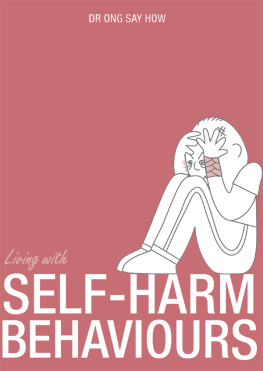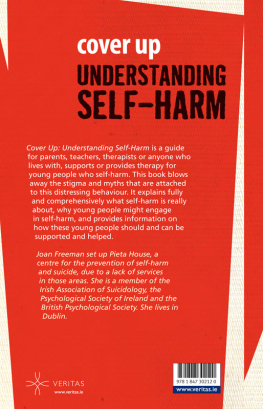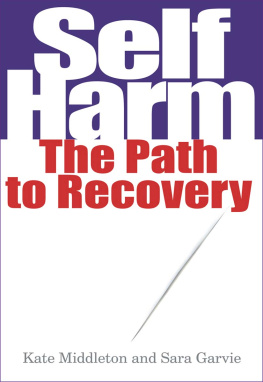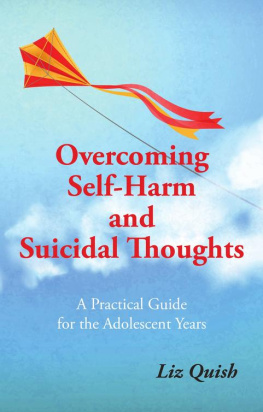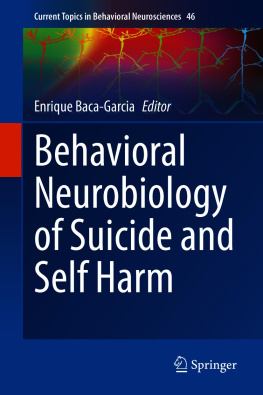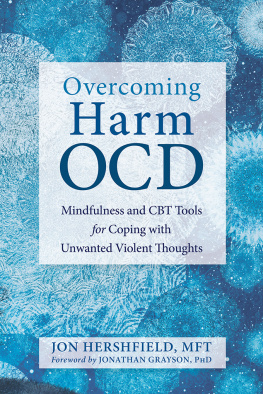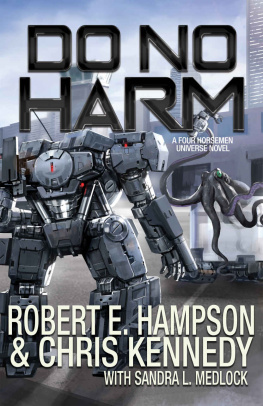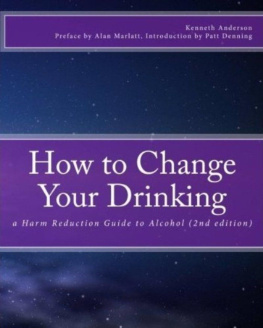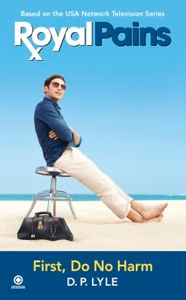Ong Say How - Living With Self-harm Behaviours
Here you can read online Ong Say How - Living With Self-harm Behaviours full text of the book (entire story) in english for free. Download pdf and epub, get meaning, cover and reviews about this ebook. year: 2015, publisher: Marshall Cavendish International, genre: Religion. Description of the work, (preface) as well as reviews are available. Best literature library LitArk.com created for fans of good reading and offers a wide selection of genres:
Romance novel
Science fiction
Adventure
Detective
Science
History
Home and family
Prose
Art
Politics
Computer
Non-fiction
Religion
Business
Children
Humor
Choose a favorite category and find really read worthwhile books. Enjoy immersion in the world of imagination, feel the emotions of the characters or learn something new for yourself, make an fascinating discovery.
- Book:Living With Self-harm Behaviours
- Author:
- Publisher:Marshall Cavendish International
- Genre:
- Year:2015
- Rating:4 / 5
- Favourites:Add to favourites
- Your mark:
- 80
- 1
- 2
- 3
- 4
- 5
Living With Self-harm Behaviours: summary, description and annotation
We offer to read an annotation, description, summary or preface (depends on what the author of the book "Living With Self-harm Behaviours" wrote himself). If you haven't found the necessary information about the book — write in the comments, we will try to find it.
Why do teenagers want to harm themselves and will it lead to suicide? What are the signs to look out for?
Living With Self-harm Behaviours — read online for free the complete book (whole text) full work
Below is the text of the book, divided by pages. System saving the place of the last page read, allows you to conveniently read the book "Living With Self-harm Behaviours" online for free, without having to search again every time where you left off. Put a bookmark, and you can go to the page where you finished reading at any time.
Font size:
Interval:
Bookmark:

2015 Marshall Cavendish International (Asia) Private Limited
Illustrations by Julie Davey
Series designer: Bernard Go
First published 2003 by Times Editions
This 2015 edition published by
Marshall Cavendish Editions
An imprint of Marshall Cavendish International
1 New Industrial Road, Singapore 536196
All rights reserved
No part of this publication may be reproduced, stored in a retrieval system or transmitted, in any form or by any means, electronic, mechanical, photocopying, recording or otherwise, without the prior permission of the copyright owner. Requests for permission should be addressed to the Publisher, Marshall Cavendish International (Asia) Private Limited, 1 New Industrial Road, Singapore 536196. Tel: (65) 6213 9300, fax: (65) 6285 4871. E-mail: .
Website: www.marshallcavendish.com/genref
The publisher makes no representation or warranties with respect to the contents of this book, and specifically disclaims any implied warranties or merchantability or fitness for any particular purpose, and shall in no event be liable for any loss of profit or any other commercial damage, including but not limited to special, incidental, consequential, or other damages.
Other Marshall Cavendish Offices
Marshall Cavendish Corporation. 99 White Plains Road, Tarrytown NY 10591-9001, USA Marshall Cavendish International (Thailand) Co Ltd. 253 Asoke, 12th Flr, Sukhumvit 21 Road, Klongtoey Nua, Wattana, Bangkok 10110, Thailand Marshall Cavendish (Malaysia) Sdn Bhd, Times Subang, Lot 46, Subang Hi-Tech Industrial Park, Batu Tiga, 40000 Shah Alam, Selangor Darul Ehsan, Malaysia
Marshall Cavendish is a trademark of Times Publishing Limited.
National Library Board, Singapore Cataloguing-in-Publication Data
Ong, Say How, author.
Living with self-harm behaviours / Dr Ong Say How; illustrations by Julie Davey.
Singapore: Marshall Cavendish Editions, 2015.
pages cm
eISBN: 978 981 4721 33 2
1. Self-destructive behavior Popular works. 2. Self-destructive behavior in children.
3. Self-destructive behavior in adolescence. 4. Children Suicidal behavior. 5. Teenagers Suicidal behavior. I. Davey, Julie, illustrator. II. Title. III. Living with.
RJ506.S39
616.858200835 dc23 OCN912354895
Printed in Singapore by Markono Print Media Pte Ltd
Dedicated to
all my patients and children of Child Guidance Clinic
and their parents
Self-harm behaviour is not uncommon in all communities and strikes people from all walks of life. It is often not spoken about because it arouses negative feelings of shame, guilt and remorse, particularly in Asian societies where it is considered taboo to talk of ones private affairs publicly. Sufferers who speak up may be ostracised and seen as weak and useless. So their plight is not known to many.
Self-harm behaviours cannot be easily wished away and should not go unnoticed. The fact that children and teenagers engage in self-harm behaviours definitely raises concerns. Why should people in the prime of their youth want to hurt themselves?
It must be recognised that young people may not necessarily have the means and resources to cope with their emotional problems. Many do not dare to turn to their parents or teachers for help. If our society does not protect and help them, then who will?
This book aims to present the facts behind self-harm behaviours for parents, teachers, counsellors and anyone who interacts with children and teenagers. This new edition also provides updates on self-harm, including recent local statistics and new community-based resources, such as REACH and CHAT, that could help young persons who experience self-harm.
I would like to thank my fellow colleagues at the Child Guidance Clinic for encouraging me to complete this book.
Dr Ong Say How
July 2015
 I came to the hospitals A&E so often that one of the nurses told me I
I came to the hospitals A&E so often that one of the nurses told me I
was a pain in the neck for having to keep coming in.
Angela, 18 years old
 The hospital staff thinks that treating us is a waste of time because they
The hospital staff thinks that treating us is a waste of time because they
should be treating people who truly want to
get better and dont deliberately hurt themselves.
Chris, 17 years old
People who intentionally harm themselves are often ostracised in society as the reasons for them doing so are poorly understood, even as we continue to learn more about them and their self-destructive behaviours. Self-harm behaviours are baffling for caregivers who cannot understand why young persons would want to harm themselves and if so, why they do so repeatedly. Parents are dumbfounded and often give up after failing to obtain any answers from their children.
These young persons may also be shunned by their friends and peers, as well as by the medical personnel who attend to them when they seek treatment at hospitals.
Self-harm behaviours can afflict both teens and even young children below 12 years old, although the occurrence in the latter age group is much lower. In this book, young persons is used to refer to youths between the ages of 12 and 18 years old.
Just what is self-harm? Why do youngsters harm themselves and what can we do about it? This book attempts to explain this phenomenon, offer new insights and suggestions on what families and schools can do to reduce its occurrence. By trying to understand individuals who self-harm, we will hopefully effect a change in them and not relegate them to the fringes of society.

Self-harm describes a wide range of acts that people deliberately do to hurt or injure themselves. A more accurate term for self-harm is Non-Suicidal Self-Injury (NSSI), which is defined as the deliberate, direct and self-inflicted destruction of body tissue resulting in immediate tissue damage, for purposes not socially sanctioned and without suicidal intent by the International Society for the Study of Self-Injury. For simplicity, the terms self-harm and non-suicidal self-injury are used interchangeably in this book.
Individuals who engage in self-harm behaviours are in great emotional turmoil. Most self-harmers feel very alone as they believe they have become different from normal people and have no one to trust or share their problems with. They have conspicuous scars on their limbs which cannot be easily explained away, and which they conceal with bandages or long-sleeved shirts.
The seriousness of the problem is not measured by how bad or how extensive the injury is. People who hurt themselves a little can be feeling just as bad as those who hurt themselves a lot. Many self-harmers hurt themselves secretly for a long time before they eventually find the courage to tell someone about it or come forward for help.
In Singapore, most cases of self-harm are caused by inflicting superficial cuts on the wrists and forearms with penknives and other sharp objects (knives, razors, broken glass, metal rulers and pins). Some common methods are:
cutting or carving on skin,
Font size:
Interval:
Bookmark:
Similar books «Living With Self-harm Behaviours»
Look at similar books to Living With Self-harm Behaviours. We have selected literature similar in name and meaning in the hope of providing readers with more options to find new, interesting, not yet read works.
Discussion, reviews of the book Living With Self-harm Behaviours and just readers' own opinions. Leave your comments, write what you think about the work, its meaning or the main characters. Specify what exactly you liked and what you didn't like, and why you think so.

